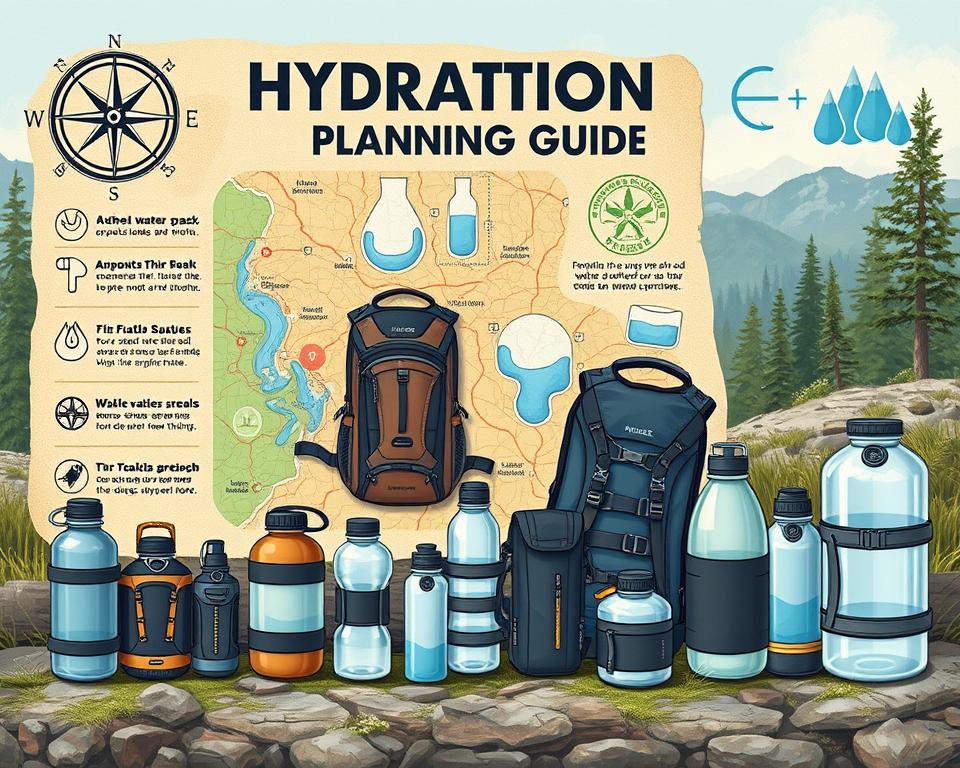Introduction: The Importance of Filtering Water on the Trail
It’s vital to make sure the water you drink on hikes is clean. Drinking unsafe water, like from streams that might look clear, could make you very ill. This is because of harmful things like germs from dead animals or pollution. Avoiding waterborne diseases such as giardia is super important, especially in places like the American west and New Zealand.
To stay safe, you need to know how to clean water in the wild. Drinking unclean water can be very risky. But, with easy steps like keeping your water filter warm in cold weather, you can be safer. This helps avoid sickness and keeps the filter working right.
There are many ways and tools to clean water while you’re enjoying the outdoors. These help you stay hydrated and safe during your adventures.
Introduction: The Importance of Filtering Water on the Trail
When hiking, it’s vital to ensure your water is safe. You must avoid unfiltered water. Even clear-looking streams can carry wilderness parasites like giardia. This bug can make you very sick.
Many things can dirty natural water sources. Things like dead animals upstream or nearby livestock. So, having effective ways to clean your water is key when outdoors.
Mechanical filters, like the Sawyer Squeeze, are top-notch. They don’t let through anything bigger than 0.1 microns. Since most harmful stuff is bigger, these filters keep you safe.
Chemicals like Aqua Mira drops are great when it’s cold and filters might freeze. I remember my filter freezing during a hike. Switching to Aqua Mira drops saved me. These chemicals work well under various conditions, keeping trail water safety intact.
UV light purifiers, like the CrazyCap 2.0, are good for areas with lots of germs. They stop germs by messing up their DNA. Still, some tests show Katadyn models might work better sometimes.
On trails, people use many methods to clean water, from filters to UV lights and chemicals. Each has its good and bad points. Knowing different methods helps keep you hydrated and healthy.
Always check the water, whether it looks clean or not. Good water sources can become bad later in your journey. That’s why knowing how to clean your water well is crucial. It helps you avoid getting sick.
Where to Collect Water on the Trail
Being on a trail means you need to know how to find water safely. It’s vital to get water from trusted sources to stay healthy and hydrated. Here, we’ll look at the best water collection spots for hikers.
Mountain Springs and Streams
Mountain springs and streams are top places for clean water outdoors. Water from these places usually has fewer impurities because it comes from high places. Still, it’s important to use a water filter to make sure you’re safe from germs or viruses. Having a map helps a lot in finding springs or streams early in the day, which is great for avoiding dehydration as it gets hotter.
Lakes and Rivers
Lakes and rivers, while not as clean as mountain sources, are good for getting water. They have a lot of water but might be mixed with more dirt and algae. It’s key to filter and maybe boil water from these places, especially at high places above 6,500 feet, boiling for three minutes makes water safe from harmful germs.
Unconventional Sources
Trails can be unpredictable, so you might need to get creative about where you find water. Sometimes you might have to use muddy ponds or even animal troughs. Using chemicals like iodine or chlorine dioxide, which are safe according to the National Sanitation Foundation, adds extra safety. UV light purifiers work well too, especially in spots where water is scarce.
Aside from a Vecto bag, you can scoop water with the bottom part of a Sawyer bag or a cut PET bottle. Some hikers prefer a cheap Ziplock bag. Using a hat or shoe is least desirable but can work if you’re in a tough spot.
In the end, getting water in the wild might mean going back or using less ideal sources. With the right tools to filter and purify, every drink can be safe, no matter where it comes from.
How Much Water to Carry
When you plan a hiking trip, it’s key to think about hydration. It keeps you healthy and safe. Figuring out the right amount of water to bring is vital. You have to think about several things that affect how much you’ll drink on your walk.
Assessing Your Water Needs
To make your hike a success, you need to know how much water to bring. Experts say to carry 1 liter of water for every 2 hours you hike. You should also drink 17-20 ounces of water 2 hours before and after your hike. For moderate weather, drink 4 ounces of water every 10 to 15 minutes. In hot weather, you’ll need to drink twice as much.

Factors Affecting Water Consumption
Several things can affect how much water you need. These factors include:
- Temperature and Humidity: You need more water in hot and humid weather.
- Exertion Levels: Harder hikes mean you’ll drink more water.
- Personal Hydration Needs: Everyone is different. Your needs depend on your health and how well you adjust to the environment.
It’s important to know the signs of dehydration. These include headaches, extreme thirst, cramps, nausea, dizziness, fatigue, and dark urine. Knowing these can help you avoid dehydration and stay healthy while hiking.
Water Carrying Tips
Carrying water efficiently can make your hike easier. Here are some tips to help:
- Use Hydration Bladders: A 3L hydration bladder lets you drink without stopping.
- Filter Water on the Go: The Sawyer Squeeze or Katadyn BeFree are great for filtering water from natural sources.
- Plan for Extra Water: Always bring extra water for cooking and emergencies, especially when you’re far from water sources.
Keep in mind that water is heavy—it weighs about 2.2 pounds per liter. Smart hydration planning helps you avoid carrying too much, while still having enough to drink.
Is It Necessary to Filter Water Before Filling My Hydro Flask on the Trail?
Filtering water before filling your Hydro Flask on the trail is crucial. It ensures you avoid contaminants and enhances the taste of your drink. Along with finding a reliable filter, consider some tips for cleaning hydro flasks regularly to maintain hygiene and prolong the life of your bottle.
Types of Water Filtration Methods
Ensuring safe drinking water in the wilderness is crucial. There are many water purification options available. Each one suits different needs and scenarios on the trail.
Options include hollow fiber filters, ceramic filters, and UV light purifiers. There are also water purification tablets and boiling water. Each method has its benefits and things to consider. This helps hikers choose the best portable water treatment for their journey.
Hollow Fiber Filters
Hollow fiber filters, like the Platypus QuickDraw and Sawyer Squeeze, are light and tough. They work well against bacteria and protozoa. This makes them a strong choice for most hiking conditions.
These filters are easy to carry and use, making them popular with backpackers. However, they do not remove viruses. Prices range from $20 to $40, and they weigh between 3 to 7 oz.
Ceramic Filters
Ceramic filters, such as the MSR MiniWorks EX, perform well in cold conditions. They’re heavier (around 15 oz) and costlier (up to $100). However, they are reliable and long-lasting.
While they effectively filter out harmful elements, they require more upkeep than other types.
Water Purification Tablets
Water purification tablets, like Katadyn Micropur Forte, offer a simple chemical treatment. They kill bacteria, viruses, and protozoa. This provides safe drinking water for up to six months.
These tablets are handy and light (costing about $10 for a 10-pack). But, they don’t filter out particles and might leave a bad taste. They need around 4 hours to work best against Cryptosporidium.
UV Light Purifiers
UV light purifiers, such as the SteriPEN Ultra, use advanced technology for purifying water. They kill all types of pathogens, including viruses. They work fast (about 90 seconds per quart) and weigh about 5 oz.
However, their effectiveness depends on battery life. This is an important factor for long hikes. You can learn more about different water treatment methods here.
Boiling Water
Boiling water is the most effective way to kill pathogens. It’s reliable but requires a lot of fuel.
To ensure safety, water should boil for one minute (three minutes at higher elevations). While effective, it’s not always practical for long trips where fuel is limited.
Choosing the right water purification method depends on the hike’s environment, length, and your preferences. Whether it’s a light hollow fiber filter or boiling water, knowing these options ensures you stay hydrated and safe during your adventures.

